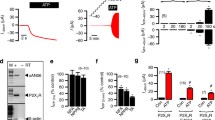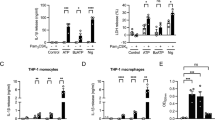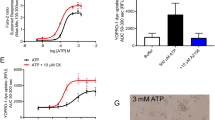Abstract
Extracellular nucleotides can modulate the immunological response by activating purinergic receptors (P2Rs) on the cell surface of macrophages, dendritic, and other immune cells. In particular, the activation of P2X7R can induce release of cytokines and cell death as well as the uptake of large molecules through the cell membrane by a mechanism still poorly understood. Polyoxotungstate-1 (POM-1) has been proposed as a potent inhibitor of ecto-nucleotidases, enzymes that hydrolyze extracellular nucleotides, regulating the activity of P2Rs. However, the potential impact of POM-1 on P2Rs has not been evaluated. Here, we used fluorescent dye uptake, cytoplasmic free Ca2+ concentration measurement, patch-clamp recordings, scanning electron microscopy, and quantification of inflammatory mediators to investigate the effects of POM-1 on P2Rs of murine macrophages. We observed that POM-1 blocks the P2YR-dependent cytoplasmic Ca2+ increase and has partial effects on the cytoplasmic Ca2+, increasing dependence on P2XRs. POM-1 can inhibit the events related with ATP-dependent inflammasome activation, anionic dye uptake, and also the opening of large conductance channels, which are associated with P2X7R-dependent pannexin-1 activation. On the other hand, this compound has no effects on cationic fluorescent dye uptake, apoptosis, and bleb formation, also dependent on P2X7R. Moreover, POM-1 can be considered an anti-inflammatory compound, because it prevents TNF-α and nitric oxide release from LPS-treated macrophages.










Similar content being viewed by others
References
Junger WG (2011) Immune cell regulation by autocrine purinergic signaling. Nat Rev Immunol 11:201–212. https://doi.org/10.1038/nri2938
Burnstock G, Boeynaems JM (2014) Purinergic signalling and immune cells. Purinergic Signal 10:529–564. https://doi.org/10.1007/s11302-014-9427-2
Burnstock G (2014) Purinergic signalling: from discovery to current developments. Exp Physiol 99:16–34. https://doi.org/10.1113/expphysiol.2013.071951
Khakh BS, North RA (2006) P2X receptors as cell-surface ATP sensors in health and disease. Nature 442:527–532. https://doi.org/10.1038/nature04886
Di Virgilio F, Vuerich M (2015) Purinergic signaling in the immune system. Auton Neurosci 191:117–123. https://doi.org/10.1016/j.autneu.2015.04.011
North RA (2002) Molecular physiology of P2X receptors. Physiol Rev 82:1013–1067. https://doi.org/10.1152/physrev.00015.2002
Virginio C, MacKenzie A, North RA, Surprenant A (1999) Kinetics of cell lysis, dye uptake and permeability changes in cells expressing the rat P2X7 receptor. J Physiol Lond 519:335–346. https://doi.org/10.1111/j.1469-7793.1999.0335m.x
Coutinho-Silva R, Persechini PM (1997) P2Z purinoceptor-associated pores induced by extracellular ATP in macrophages and J774 cells. Am J Phys 273:C1793–C1800
Pelegrin P, Surprenant A (2006) Pannexin-1 mediates large pore formation and interleukin-1beta release by the ATP-gated P2X7 receptor. EMBO J 25:5071–5082. https://doi.org/10.1038/sj.emboj.7601378
Schachter J, Motta AP, de Souza Zamorano A, da Silva-Souza HA, Guimarães MZ, Persechini PM (2008) ATP-induced P2X7-associated uptake of large molecules involves distinct mechanisms for cations and anions in macrophages. J Cell Sci 121:3261–3270. https://doi.org/10.1242/jcs.029991
Cankurtaran-Sayar S, Sayar K, Ugur M (2009) P2X7 receptor activates multiple selective dye-permeation pathways in RAW 264.7 and human embryonic kidney 293 cells. Molecular Pharmacol 76:1323–1332. https://doi.org/10.1124/mol.109.059923
Li M, Toombes GE, Silberberg SD, Swartz KJ (2015) Physical basis of apparent pore dilation of ATP-activated P2X receptor channels. Nat Neurosci 18:1577–1583. https://doi.org/10.1038/nn.4120
Csóka B, Németh ZH, Törő G, Idzko M, Zech A, Koscsó B, Spolarics Z, Antonioli L, Cseri K, Erdélyi K, Pacher P, Haskó G (2015) Extracellular ATP protects against sepsis through macrophage P2X7 purinergic receptors by enhancing intracellular bacterial killing. FASEB J 29:3626–3637. https://doi.org/10.1096/fj.15-272450
Di Virgilio F, Chiozzi P, Ferrari D, Falzoni S, Sanz JM, Morelli A, Torboli M, Bolognesi G, Baricordi OR (2001) Nucleotide receptors: an emerging family of regulatory molecules in blood cells. Blood 97:587–600. https://doi.org/10.1182/blood.V97.3.587
Coutinho-Silva R, Stahl L, Raymond MN, Jungas T, Verbeke P, Burnstock G, Darville T, Ojcius DM (2003) Inhibition of chlamydial infectious activity due to P2X7R-dependent phospholipase D activation. Immunity 19:403–412. https://doi.org/10.1016/S1074-7613(03)00235-8
Ferrari D, Pizzirani C, Adinolfi E, Lemoli RM, Curti A, Idzko M, Panther E, Di Virgilio F (2006) The P2X7 receptor: a key player in IL-1 processing and release. J Immunol 176:3877–3883. https://doi.org/10.4049/jimmunol.176.7.3877
Pfeiffer ZA, Aga M, Prabhu U, Watters JJ, Hall DJ, Bertics PJ (2004) The nucleotide receptor P2X7 mediates actin reorganization and membrane blebbing in RAW 264.7 macrophages via p38 MAP kinase and Rho. J Leukoc Biol 75:1173–1182. https://doi.org/10.1189/jlb.1203648
Zimmermann H, Zebisch M, Sträter N (2012) Cellular function and molecular structure of ecto-nucleotidases. Purinergic Signal 5:437–502. https://doi.org/10.1007/s11302-012-9309-4
Dwyer KM, Deaglio S, Gao W, Friedman D, Strom TB, Robson SC (2007) CD39 and control of cellular immune responses. Purinergic Signal 3:171–180. https://doi.org/10.1007/s11302-006-9050-y
Morandini AC, Savio LE, Coutinho-Silva R (2014) The role of P2X7 receptor in infectious inflammatory diseases and the influence of ectonucleotidases. Biom J 37:169–177. https://doi.org/10.4103/2319-4170.127803
Antonioli L, Yegutkin GG, Pacher P, Blandizzi C, Hasko G (2016) Anti-CD73 in cancer immunotherapy: awakening new opportunities. Trends Cancer 2:95–109. https://doi.org/10.1016/j.trecan.2016.01.003
Schachter J, Delgado KV, Barreto-de-Souza V, Bou-Habib DC, Persechini PM, Meyer-Fernandes JR (2015) Inhibition of ecto-ATPase activities impairs HIV-1 infection of macrophages. Immunobiology 220(5):589–596. https://doi.org/10.1016/j.imbio.2014.12.004
Baqi Y (2015) Ecto-nucleotidase inhibitors: recent developments in drug discovery. Mini Rev Med Chem 15:21–33. https://doi.org/10.2174/1389557515666150219115141
Munkonda MN, Kauffenstein G, Kukulski F, Lévesque SA, Legendre C, Pelletier J, Lavoie EG, Lecka J, Sévigny J (2007) Inhibition of human and mouse plasma membrane bound NTPDases by P2 receptor antagonists. Biochem Pharmacol 74:1524–1534. https://doi.org/10.1016/j.bcp.2007.07.033
Dunn PM, Blakeley AG (1988) Suramin: a reversible P2-purinoceptor antagonist in the mouse vas deferens. Br J Pharmacol 93:243–245
Chen BC, Lee CM, Lin WW (1996) Inhibition of ecto-ATPase by PPADS, suramin and reactive blue in endothelial cells, C6 glioma cells and RAW 264.7 macrophages. Br J Pharmacol 119:1628–1634
Gendron FP, Benrezzak O, Krugh BW, Kong Q, Weisman GA, Beaudoin AR (2002) Purine signaling and potential new therapeutic approach: possible outcomes of NTPDase inhibition. Curr Drug Targets 3:229–245. https://doi.org/10.2174/1389450023347713
Lee SY, Fiene A, Li W, Hanck T, Brylev KA, Fedorov VE, Lecka J, Haider A, Pietzsch HJ, Zimmermann H, Sévigny J, Kortz U, Stephan H, Müller CE (2015) Polyoxometalates-potent and selective ecto-nucleotidase inhibitors. Biochem Pharmacol 15:171–181. https://doi.org/10.1016/j.bcp.2014.11.002
Kohler D, Eckle T, Faigle M, Grenz A, Mittelbronn M, Laucher S, Hart ML, Robson SC, Müller CE, Eltzschig HK (2007) CD39/ectonucleoside triphosphate diphosphohydrolase 1 provides myocardial protection during cardiac ischemia/reperfusion injury. Circulation 116:1784–1794. https://doi.org/10.1161/CIRCULATIONAHA.107.690180
Grenz A, Zhang H, Hermes M, Eckle T, Klingel K, Huang DY, Müller CE, Robson SC, Osswald H, Eltzschig HK (2007) Contribution of E-NTPDase1 (CD39) to renal protection from ischemia-reperfusion injury. FASEB J 21:2863–2873. https://doi.org/10.1096/fj.06-7947com
Müller CE, Iqbal J, Baqi Y, Zimmermann H, Röllich A, Stephan H (2006) Polyoxometalates-a new class of potent ecto-nucleoside triphosphate diphosphohydrolase (NTPDase) inhibitors. Bioorg Med Chem Lett 16:5943–5947. https://doi.org/10.1016/j.bmcl.2006.09.003
Zhai F, Li D, Zhang C, Wang X, Li R (2008) Synthesis and characterization of polyoxometalates loaded starch nanocomplex and its antitumoral activity. Eur J Med Chem 43:1911–1917. https://doi.org/10.1016/j.ejmech.2007.11.032
Seko A, Yamase T, Yamashita K (2009) Polyoxometalates as effective inhibitors for sialyl- and sulfotransferases. J Inorg Biochem 103:1061–1066. https://doi.org/10.1016/j.jinorgbio.2009.05.002
Turner TL, Nguyen VH, McLauchlan CC, Dymon Z, Dorsey BM, Hooker JD, Jones MA (2012) Inhibitory effects of decavanadate on several enzymes and Leishmania tarentolae in vitro. J Inorg Biochem 108:96–104. https://doi.org/10.1016/j.jinorgbio.2011.09.009
Qi Y, Xiang Y, Wang J, Qi Y, Li J, Niu J, Zhong J (2013) Inhibition of hepatitis C virus infection by polyoxometalates. Antivir Res 100:392–398. https://doi.org/10.1016/j.antiviral.2013.08.025
Nomiya K, Torii H, Hasegawa T, Nemoto Y, Nomura K, Hashino K, Uchida M, Kato Y, Shimizu K, Oda M (2001) Insulin mimetic effect of a tungstate cluster. Effect of oral administration of homopolyoxotungstates and vanadium-substituted polyoxotungstates on blood glucose level of STZ mice. J Inorg Biochem 86:657–667. https://doi.org/10.1016/S0162-0134(01)00233-1
Amobi NI, Guillebaud J, Smith IC (2012) Perspective on the role of P2X-purinoceptor activation in human vas deferens contractility. Exp Physiol 97:583–602. https://doi.org/10.1113/expphysiol.2011.063206
Pinheiro AR, Paramos-de-Carvalho D, Certal M, Costa C, Magalhães-Cardoso MT, Ferreirinha F, Costa MA, Correia-de-Sá P (2013) Bradykinin-induced Ca2+ signaling in human subcutaneous fibroblasts involves ATP release via hemichannels leading to P2Y12 receptors activation. Cell Commun Signal 18:70. https://doi.org/10.1186/1478-811X-11-70
Wan P, Liu X, Xiong Y, Ren Y, Chen J, Lu N, Guo Y, Bai A (2016) Extracellular ATP mediates inflammatory responses in colitis via P2X7 receptor signaling. Sci Rep 6:19108. https://doi.org/10.1038/srep19108
Lanzetta PA, Alvarez LJ, Reinach PS, Candia OA (1979) An improved assay for nanomole amounts of inorganic phosphate. Anal Biochem 100:95–97. https://doi.org/10.1016/0003-2697(79)90115-5
Russo-Abrahão T, Cosentino-Gomes D, Gomes MT, Alviano DS, Alviano CS, Lopes AH, Meyer-Fernandes JR (2011) Biochemical properties of Candida parapsilosis ecto-5′-nucleotidase and the possible role of adenosine in macrophage interaction. FEMS Microbiol Lett 317:34–42. https://doi.org/10.1111/j.1574-6968.2011.02216.x
Hamill OP, Marty A, Neher E, Sakmann B, Sigworth FJ (1981) Improved patch-clamp techniques for high-resolution current recording from cells and cell-free membrane patches. Eur. J Physiol 391:85–100
Riccardi C, Nicoletti I (2006) Analysis of apoptosis by propidium iodide staining and flow cytometry. Nat Protoc 1:1458–1461. https://doi.org/10.1038/nprot.2006.238
da Silva-Souza HA, Lira MN, Costa-Junior HM, da Cruz CM, Vasconcellos JS, Mendes AN, Pimenta-Reis G, Alvarez CL, Faccioli LH, Serezani CH, Schachter J, Persechini PM (2014) Inhibitors of the 5-lipoxygenase arachidonic acid pathway induce ATP release and ATP-dependent organic cation transport in macrophages. Biochim Biophys Acta 1838:1967–1977. https://doi.org/10.1016/j.bbamem.2014.04.006
Granger DL, Taintor RR, Boockvar KS, Hibbs JB Jr (1996) Measurement of nitrate and nitrite in biological samples using nitrate reductase and Griess reaction. Methods Enzymol 268:142–151
von Kügelgen I, Hoffmann K (2016) Pharmacology and structure of P2Y receptors. Neuropharmacology 104:50–61. https://doi.org/10.1016/j.neuropharm.2015.10.030
Jacobson KA, Müller CE (2016) Medicinal chemistry of adenosine, P2Y and P2X receptors. Neuropharmacology 104:31–49. https://doi.org/10.1016/j.neuropharm.2015.12.001
Costa-Junior HM, Mendes AN, Davis GHNG, Monteiro-da-Cruz C, Ventura AL, Serezani CH, Faccioli LH, Freire-de-Lima CG, Bisaggio RC, Persechini PM (2009) ATP-induced apoptosis involves a Ca2+-independent phospholipase A2 and 5-lipoxygenase in macrophages. Prostaglandins Other Lipid Mediat 88:51–61. https://doi.org/10.1016/j.prostaglandins.2008.09.004
Hu Z, Murakami T, Suzuki K, Tamura H, Kuwahara-Arai K, Iba T, Nagaoka I (2014) Antimicrobial cathelicidin peptide LL-37 inhibits the LPS/ATP-induced pyroptosis of macrophages by dual mechanism. PLoS One 9:e85765. https://doi.org/10.1371/journal.pone.0085765
Keller H, Rentsch P, Hagmann J (2002) Differences in cortical actin structure and dynamics document that different types of blebs are formed by distinct mechanisms. Exp Cell Res 277:161–172. https://doi.org/10.1006/excr.2002.5552
Verhoef PA, Estacion M, Schilling W, Dubyak GR (2003) P2X7 receptor-dependent blebbing and the activation of Rho-effector kinases, caspases, and IL-1 release. J Immunol 170:5728–5738. https://doi.org/10.4049/jimmunol.170.11.5728
Pan Y, Shen B, Gao Q, Zhu J, Dong J, Zhang L, Zhang Y (2016) Caspase-1 inhibition attenuates activation of BV2 microglia induced by LPS-treated RAW 264.7 macrophages. J Biomed Res 30:225–233. https://doi.org/10.7555/JBR.30.20150141
Sperlagh B, Hasko G, Nemeth Z, Vizi ES (1998) ATP released by LPS increases nitric oxide production in raw 264.7 macrophage cell line via P2Z/P2X7 receptors. Neurochem Int 33:209–215. https://doi.org/10.1016/S0197-0186(98)00025-4
Sakaki H, Tsukimoto M, Harada H, Moriyama Y, Kojima S (2013) Autocrine regulation of macrophage activation via exocytosis of ATP and activation of P2Y11 receptor. PLoS One 8:e59778. https://doi.org/10.1371/journal.pone.0059778
Lévesque SA, Kukulski F, Enjyoji K, Robson SC, Sévigny J (2010) NTPDase1 governs P2X7-dependent functions in murine macrophages. Eur J Immunol 40:1473–1485. https://doi.org/10.1002/eji.200939741
Zanin RF, Braganhol E, Bergamin LS, Campesato LF, Filho AZ, Moreira JC, Morrone FB, Sévigny J, Schetinger MR, de Souza Wyse AT, Battastini AM (2012) Differential macrophage activation alters the expression profile of NTPDase and ecto-5′-nucleotidase. PLoS One 7:e31205. https://doi.org/10.1371/journal.pone.0031205
Wall MJ, Wigmore G, Lopatár J, Frenguelli BG, Dale N (2008) The novel NTPDase inhibitor sodium polyoxotungstate (POM-1) inhibits ATP breakdown but also blocks central synaptic transmission, an action independent of NTPDase inhibition. Neuropharmacology:1251–1258. https://doi.org/10.1016/j.neuropharm.2008.08.005
Van Kolen K, Slegers H (2006) Integration of P2Y receptor-activated signal transduction pathways in G protein-dependent signalling networks. Purinergic Signal 2:451–469. https://doi.org/10.1007/s11302-006-9008-0
Coutinho-Silva R, Ojcius DM, Górecki DC, Persechini PM, Bisaggio RC, Mendes AN, Marks J, Burnstock G, Dunn PM (2005) Multiple P2X and P2Y receptor subtypes in mouse J774, spleen and peritoneal macrophages. Biochem Pharmacol 69:641–655. https://doi.org/10.1016/j.bcp.2004.11.012
da Cruz CM, Ventura AL, Schachter J, Costa-Junior HM, da Silva Souza HA, Gomes FR, Coutinho-Silva R, Ojcius DM, Persechini PM (2006) Activation of ERK1/2 by extracellular nucleotides in macrophages is mediated by multiple P2 receptors independently of P2X7-associated pore or channel formation. Br J Pharmacol 147:324–334. https://doi.org/10.1038/sj.bjp.0706559
Mehta VB, Hart J, Wewers MD (2001) ATP-stimulated release of interleukin (IL)-1 and IL-18 requires priming by lipopolysaccharide and is independent of caspase-1 cleavage. J Biol Chem 276:3820–3826. https://doi.org/10.1074/jbc.M006814200
Miao EA, Rajan JV, Aderem A (2011) Caspase-1-induced pyroptotic cell death. Immunol Rev 243:206–214. https://doi.org/10.1111/j.1600-065X.2011.01044.x
Lamkanfi M, Kalai M, Saelens X, Declercq W, Vandenabeele P (2004) Caspase-1 activates nuclear factor of the kappa-enhancer in B cells independently of its enzymatic activity. J Biol Chem 279:24785–24793. https://doi.org/10.1074/jbc.M400985200
Pan Y, Shen B, Gao Q, Zhu J, Dong J, Zhang L, Zhang Y (2016) Caspase-1 inhibition attenuates activation of BV2 microglia induced by LPS-treated RAW264.7 macrophages. J Biomed Res 30:225–233. https://doi.org/10.7555/JBR.30.20150141
Lee J, Choi J, Kim S (2015) Effective suppression of pro-inflammatory molecules by DHCA via IKK-NF-κB pathway, in vitro and in vivo. Br J Pharmacol 172:3353–3369. https://doi.org/10.1111/bph.13137
Kong Q, Wang M, Liao Z, Camden JM, Yu S, Simonyi A, Sun GY, Gonzalez FA, Erb L, Seye CI, Weisman GA (2005) (2005) P2X7 nucleotide receptors mediate caspase-8/9/3-dependent apoptosis in rat primary cortical neurons. Purinergic Signal 1:337–347. https://doi.org/10.1007/s11302-005-7145-5
Hanley PJ, Kronlage M, Kirschning C, del Rey A, Di Virgilio F, Leipziger J, Chessell IP, Sargin S, Filippov MA, Lindemann O, Mohr S, Königs V, Schillers H, Bähler M, Schwab A (2012) Transient P2X7 receptor activation triggers macrophage death independent of Toll-like receptors 2 and 4, caspase-1, and pannexin-1 proteins. J Biol Chem 287:10650–10663. https://doi.org/10.1074/jbc.M111.332676
Mackenzie AB, Young MT, Adinolfi E, Surprenant A (2005) Pseudoapoptosis induced by brief activation of ATP-gated P2X7 receptors. J Biol Chem 280:33968–33976. https://doi.org/10.1074/jbc.M502705200
Roger S, Pelegrin P, Surprenant A (2008) Facilitation of P2X7 receptor currents and membrane blebbing via constitutive and dynamic calmodulin binding. J Neurosci 28:6393–6401. https://doi.org/10.1523/JNEUROSCI.0696-08.2008
Noronha-Matos JB, Coimbra J, Sá-e-Sousa A, Rocha R, Marinhas J, Freitas R, Guerra-Gomes S, Ferreirinha F, Costa MA, Correia-de-Sá P (2014) P2X7-induced zeiosis promotes osteogenic differentiation and mineralization of postmenopausal bone marrow-derived mesenchymal stem cells. FASEB J 28:5208–5222. https://doi.org/10.1096/fj.14-257923
Pelegrin P, Surprenant A (2009) The P2X(7) receptor-pannexin connection to dye uptake and IL-1beta release. Purinergic Signal 5:129–137. https://doi.org/10.1007/s11302-009-9141-7
Qu Y, Misaghi S, Newton K, Gilmour LL, Louie S, Cupp JE, Dubyak GR, Hackos D, Dixit VM (2011) Pannexin-1 is required for ATP release during apoptosis but not for inflammasome activation. J Immunol 186:6553–6561. https://doi.org/10.4049/jimmunol.1100478
Kayagaki N, Warming S, Lamkanfi M, Vande Walle L, Louie S, Dong J, Newton K, Qu Y, Liu J, Heldens S, Zhang J, Lee WP, Roose-Girma M, Dixit VM (2011) Non-canonical inflammasome activation targets caspase-11. Nature 479:117–121. https://doi.org/10.1038/nature10558
Yang D, He Y, Muñoz-Planillo R, Liu Q, Núñez G (2015) Caspase-11 requires the pannexin-1 channel and the purinergic P2X7 pore to mediate pyroptosis and endotoxic shock. Immunity 43:923–932. https://doi.org/10.1016/j.immuni.2015.10.009
Acknowledgements
We thank the National Institute of Science and Technology for Structural Biology and Bioimaging—Microscopy Division (CENABIO-UFRJ) for allowing use of the scanning electron microscope.
Funding
This research received financial support from CNPq, FAPERJ and FINEP.
Author information
Authors and Affiliations
Corresponding author
Ethics declarations
Conflicts of interest
Gabriela Pimenta-dos-Reis declares that she has no conflict of interest.
Eduardo José Lopes Torres declares that he has no conflict of interest.
Paula Gabriela Quintana declares that she has no conflict of interest.
Lincon Onorio Vidal declares that he has no conflict of interest.
Bárbara Andréa Fortes dos Santos declares that she has no conflict of interest.
Chuan-Sheng Lin declares that he has no conflict of interest.
Norton Heise declares that he has no conflict of interest.
Pedro Muanis Persechini declares that he has no conflict of interest.
Julieta Schachter declares that she has no conflict of interest.
Ethical approval
All animals were used according to the guidelines for animal use in scientific experiments of the Carlos Chagas Filho Institute of Biophysics of Federal University of Rio de Janeiro. The protocols were approved by the Research Ethics Committee on Animal Care of the Health Science Center of Federal University of Rio de Janeiro (protocol number 001200.001568/2013-87).
Rights and permissions
About this article
Cite this article
Pimenta-dos-Reis, G., Torres, E.J.L., Quintana, P.G. et al. POM-1 inhibits P2 receptors and exhibits anti-inflammatory effects in macrophages. Purinergic Signalling 13, 611–627 (2017). https://doi.org/10.1007/s11302-017-9588-x
Received:
Accepted:
Published:
Issue Date:
DOI: https://doi.org/10.1007/s11302-017-9588-x




